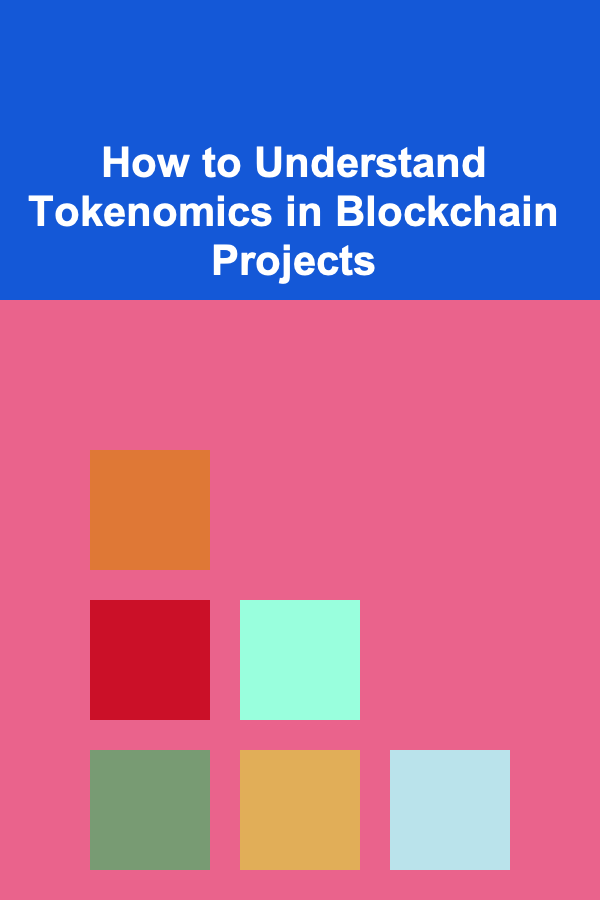
How to Understand Tokenomics in Blockchain Projects
ebook include PDF & Audio bundle (Micro Guide)
$12.99$8.99
Limited Time Offer! Order within the next:

Tokenomics, a blend of "token" and "economics," refers to the study and design of the economic systems within blockchain projects. As blockchain technology continues to disrupt industries ranging from finance to supply chains and beyond, understanding tokenomics is becoming essential for developers, investors, and enthusiasts. The concept of tokenomics goes beyond just the creation of tokens; it encompasses the entire lifecycle of a token, its role within the ecosystem, and the incentives that guide participant behavior. In this article, we will dive deep into the core principles of tokenomics, its importance, its components, and how to understand and evaluate tokenomics in blockchain projects.
What Is Tokenomics?
Tokenomics is a multidisciplinary field that combines principles of economics, game theory, cryptography, and behavioral science to design the mechanics of tokens in blockchain ecosystems. A token in the context of blockchain is a digital asset that represents value, ownership, or utility within a given network or platform. Tokenomics is crucial because it governs the supply, demand, and behavior surrounding these tokens, which ultimately impacts the success or failure of a blockchain project.
Tokenomics can be understood as the study of:
- How tokens are issued: The mechanisms for creating and distributing tokens.
- How tokens are used: The roles and functions tokens serve within the blockchain ecosystem.
- How token value is sustained or grown: The economic incentives and governance structures that influence token value over time.
- How token supply is controlled: Mechanisms like token burning, staking, and inflationary/deflationary models that help manage the supply of tokens.
Understanding tokenomics is vital for anyone interacting with blockchain projects, as it helps to assess the long-term sustainability of the project and the potential rewards and risks involved.
Key Components of Tokenomics
To fully understand tokenomics, it's essential to break it down into key components that collectively influence a blockchain project's economic model. These components interact with each other and ultimately determine the utility, value, and viability of a project's token.
1. Token Supply
One of the most fundamental aspects of tokenomics is determining the total supply of tokens. The total supply governs how many tokens exist in circulation and can influence their scarcity and value. There are different models for token supply, each with unique economic implications.
- Fixed Supply: Some projects opt for a fixed supply, meaning that the maximum number of tokens that can ever exist is predetermined. Bitcoin, for example, has a total supply of 21 million coins. This scarcity can create long-term value if demand for the token increases.
- Inflationary Supply: In some tokenomics models, tokens are issued over time through mechanisms like mining or staking. These models are typically designed to incentivize early participants and reward network validators. However, inflationary tokenomics may reduce the token's value over time if the inflation rate is too high and not balanced with demand.
- Deflationary Supply: Deflationary models aim to decrease the total supply of tokens over time, often through burning mechanisms. Token burning is the process of permanently removing tokens from circulation, which theoretically increases scarcity and value.
The supply model has a significant impact on a token's price volatility, stability, and its ability to be used as a store of value or a medium of exchange.
2. Token Distribution
Token distribution refers to how tokens are allocated to different participants in the ecosystem, including developers, investors, the community, and any other stakeholders. The distribution model impacts both the project's long-term growth and the perceived fairness of the system. There are various methods for distributing tokens, and they come with different economic incentives:
- Initial Coin Offering (ICO): ICOs were one of the earliest methods of token distribution, where projects would sell tokens to investors in exchange for capital. However, ICOs have come under scrutiny due to regulatory concerns and the potential for pump-and-dump schemes.
- Initial Exchange Offering (IEO): An IEO is similar to an ICO, but the token sale is conducted on a cryptocurrency exchange. This method can offer more credibility, as the exchange typically performs due diligence on the project.
- Airdrops: Airdrops distribute tokens for free to users, often to promote the project or reward existing holders. Airdrops can help build a strong community and increase token awareness.
- Staking: Staking involves locking tokens into a network to support blockchain operations, such as validating transactions or securing the network. In return, stakers often earn additional tokens, creating incentives for active participation.
- Mining: In proof-of-work (PoW) blockchains, mining is used to distribute tokens to participants who contribute computational power to secure the network.
Token distribution also involves considerations for vesting schedules (to prevent founders and early investors from dumping tokens on the market too soon), airdrops (which reward token holders), and staking rewards (which incentivize network security and growth).
3. Token Utility
Understanding the utility of a token is essential when evaluating a blockchain project. A token's utility defines its use case and how it contributes to the functionality of the platform. There are several ways tokens can be used:
- Payment or Medium of Exchange: Tokens can serve as a means of payment within the blockchain ecosystem, facilitating transactions between participants.
- Governance: Some blockchain projects use tokens to give holders voting rights, enabling them to influence the direction of the project's development. This is common in decentralized autonomous organizations (DAOs), where token holders vote on proposals related to the governance of the platform.
- Access to Services: Tokens can act as access keys to specific services, features, or content within the platform. For example, tokens might be required to access certain decentralized applications (dApps) or participate in specific activities within the ecosystem.
- Staking and Security: In proof-of-stake (PoS) blockchains, tokens are used as collateral to secure the network. Stakers are rewarded with additional tokens for locking up their assets, which in turn helps to validate transactions and ensure the integrity of the network.
- Reward Mechanisms: Tokens can be used as rewards for network participation, such as mining, staking, or providing liquidity to decentralized finance (DeFi) protocols.
The utility of a token is critical to its long-term success. A token with limited or no utility may struggle to retain its value, while one with widespread utility can foster a thriving ecosystem.
4. Incentive Mechanisms
Incentive structures within tokenomics ensure that participants have a vested interest in supporting and engaging with the blockchain network. These incentives are designed to align the interests of users, developers, validators, and other stakeholders. Common incentive mechanisms include:
- Staking Rewards: Participants who lock their tokens in a staking system can earn rewards over time, encouraging them to hold their tokens rather than selling them.
- Mining Rewards: In proof-of-work (PoW) systems, miners are incentivized with new tokens for validating transactions and securing the network.
- Transaction Fees: Blockchain platforms may charge users a small fee for making transactions, with a portion of the fee going to validators or network participants.
- Token Burning: As mentioned earlier, burning tokens is a deflationary mechanism that reduces the circulating supply, thus potentially increasing the value of the remaining tokens.
Incentive mechanisms are crucial to ensuring that participants engage in behaviors that benefit the platform and its users. A poorly designed incentive structure can lead to undesirable outcomes, such as excessive speculation or network manipulation.
5. Governance
Governance in tokenomics refers to the mechanisms that allow token holders and other stakeholders to make decisions about the future of the project. Blockchain governance can be either centralized or decentralized, with decentralized governance being one of the key tenets of many blockchain projects.
- Centralized Governance: In centralized governance models, decisions are made by a single entity or a small group of developers. While this approach allows for faster decision-making, it may undermine the decentralized ethos of the blockchain.
- Decentralized Governance: Decentralized governance allows token holders to vote on proposals and influence decisions. This model is characteristic of decentralized autonomous organizations (DAOs), where decisions are made through consensus among token holders.
Good governance ensures that the project can adapt to changes in the ecosystem and that participants have a voice in shaping its future. Poor governance can result in stagnation, mismanagement, or exploitation of the community by bad actors.
How to Evaluate Tokenomics in Blockchain Projects
To properly evaluate tokenomics, it's crucial to understand how all the components interact with each other and whether the economic model is sustainable. Here are a few key questions to ask when assessing tokenomics:
- What is the total supply of tokens, and how does it affect scarcity?
- How are tokens distributed, and what incentives do participants have to hold or spend tokens?
- What is the utility of the token, and how does it fit into the overall ecosystem?
- What are the incentives for network participants, and are they sustainable over the long term?
- How is governance structured, and who makes key decisions about the project's future?
- What mechanisms are in place to maintain the token's value, such as staking rewards, deflationary models, or token burning?
By asking these questions and considering how they interact, you can gain a clearer understanding of whether a blockchain project's tokenomics is well-designed and capable of supporting long-term growth and sustainability.
Conclusion
Tokenomics is a critical aspect of any blockchain project, influencing its economic viability, growth, and the value of its tokens. By understanding the key components---such as token supply, distribution, utility, incentives, and governance---you can make informed decisions about the sustainability of blockchain projects and the potential risks and rewards of participating in them. A well-designed tokenomics model can drive adoption, foster community engagement, and align the interests of all stakeholders, while a poorly designed one can result in a project's downfall. Understanding tokenomics is not just for developers or investors; it's essential for anyone seeking to navigate the increasingly complex world of blockchain and cryptocurrency.

Essential DIY Household Maintenance and Repairs Every Homeowner Should Know
Read More
How to Create a Fundraising Campaign Checklist for Success
Read More
How to Increase Your Savings Rate on a Modest Income
Read More
10 Tips for Saving for a Down Payment While Renting
Read More
10 Tips for Perfect Paint Weathering on Model Tanks
Read More
10 Tips for a Tech-Savvy Reception Venue Checklist: AV & Wi-Fi
Read MoreOther Products

Essential DIY Household Maintenance and Repairs Every Homeowner Should Know
Read More
How to Create a Fundraising Campaign Checklist for Success
Read More
How to Increase Your Savings Rate on a Modest Income
Read More
10 Tips for Saving for a Down Payment While Renting
Read More
10 Tips for Perfect Paint Weathering on Model Tanks
Read More